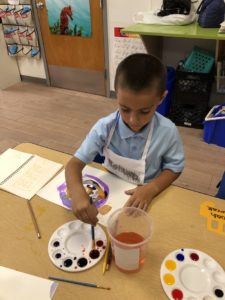 As any family with a child enrolled at Summit Kids Academy knows, a well-rounded approach to education is integral to everything we do. Summit believes that the hours children spend in its afterschool program are precious. After examining the research on afterschool arts education programming, Summit has landed on an arts focus in its own afterschool programming for young children. A multidisciplinary approach, with a variety of materials and media, makes for an engaging program that helps children develop on many levels.
As any family with a child enrolled at Summit Kids Academy knows, a well-rounded approach to education is integral to everything we do. Summit believes that the hours children spend in its afterschool program are precious. After examining the research on afterschool arts education programming, Summit has landed on an arts focus in its own afterschool programming for young children. A multidisciplinary approach, with a variety of materials and media, makes for an engaging program that helps children develop on many levels.
The Importance of Afterschool Programs
There is little doubt as to the importance of afterschool programs for young children. Aftercare program attendance is associated with improved academic performance, a reduction in behavioral challenges, and better physical health and fitness.
A 2007 study demonstrated that attending an afterschool program had an effect on the academic performance of 40 percent of students enrolled in the study. In fact, the students who attended more often were more likely do make academic gains. Their reading and math grades noticeably improved. Another recent study showed an increase in academic performance along with classroom behavior and attendance, and a reduction in dropout rates.
In fact, afterschool programs have shown that combat behavioral problems like drug use and criminal behavior in older kids. Enrolling children in aftercare programs at a young age sets them up with a schedule that will follow them through their grade school, middle school, and teenage years, and will lead to greater outcomes on a number of levels.
Afterschool programs even have impactful effects on physical health and wellness. Children’s participation in afterschool programs has a positive effect on their dietary habits as well as their physical activity. Studies have shown that children who are enrolled in aftercare programs have associated positive health outcomes, including a reduction in childhood obesity.
 Why the Arts Matter in Afterschool Programs
Why the Arts Matter in Afterschool Programs
The arts have an important place in the curriculum of any aftercare program. The arts make a considerable difference in the way that children learn in four main areas: cognition, creativity, communication, and culture, according to the National Assessment of Education Progress in the Arts.
Research has shown that in the area of cognition, the arts make children more critical in their thinking, and help them problem solve and make decisions. Harvard University’s Project Zero explores the relationship of the arts with learning, and suggests that an arts education has a profound impact on spatial intelligence, kinesthetic intelligence, and interpersonal intelligence.
In terms of creativity, an emphasis on the arts in education can impact creativity on many levels, including innovation, business planning, and scientific discovery. When your little one is enrolled in an afterschool arts program that stimulates her skills in the visual arts and music, she will learn basic skills that provide her with multiple competencies she will use as she grows into adulthood.
An arts education in early childhood also helps children to communicate using nonverbal media. Young children are still developing verbal skills and may not always have the skill level or the confidence to express complex ideas or emotions verbally. The arts can be a great way for them to explore their ideas and communicate them outwardly using drawing and painting, sculpture and dance.
 Arts education advocate Dr. Charles Fowler stated that the arts allow children to expand the way they learn culturally. This is because they can understand and appreciate the art of cultures different from their own. Arts education promotes cross-cultural understanding, and allows children to reach across cultural barriers to communicate with and understand different societies and people.
Arts education advocate Dr. Charles Fowler stated that the arts allow children to expand the way they learn culturally. This is because they can understand and appreciate the art of cultures different from their own. Arts education promotes cross-cultural understanding, and allows children to reach across cultural barriers to communicate with and understand different societies and people.
Summit’s Philosophy on Afterschool Arts Education
At Summit Kids Academy, the impacts that afterschool arts programs and arts education has on young children has inspired a host of activities. Summit knows that when parents enroll their children in aftercare programs, they expect a level of enrichment that makes the most of these crucial hours of the day.
Summit’s afterschool arts program for school-age children is a unique opportunity that is focused on the visual arts. This program teaches children to employ a variety of artistic techniques using a multitude of styles and media. The afterschool program also helps young children to develop an appreciation for the arts which will last a lifetime. Summit Kids Academy’s Creative Art Program encourages children to use sketching, drawing, acrylic painting, watercolors, mixed media, design, and sculpture.
 Each time a child starts a project in the Summit Kids afterschool arts program, teachers work with the child to tailor the project so that it fits their interests and ability levels. This way, every child participating feels confident and empowered to make the most of their time creating visual art. In fact, Summit places a specific importance on keeping the arts programming fun and positive for each child, to encourage increased participation and skill building.
Each time a child starts a project in the Summit Kids afterschool arts program, teachers work with the child to tailor the project so that it fits their interests and ability levels. This way, every child participating feels confident and empowered to make the most of their time creating visual art. In fact, Summit places a specific importance on keeping the arts programming fun and positive for each child, to encourage increased participation and skill building.
In order to complement their artistic work, children enrolled in afterschool programs will also have the opportunity to participate in outdoor play time in Summit’s secure, onsite playground. They will also have access to healthy snacks, as well as homework support. In this way, Summit nurtures the whole child during its afterschool programming.
Summit takes research on afterschool arts programming seriously, and has a firm commitment to bringing the arts into its afterschool program. Its programming will engage children and expand on the development and learning they do every day as their malleable young minds continue to grow. Summit’s afterschool arts education opportunities are a source of joy, learning, and pride amongst its students, who look forward to this programming each day.

